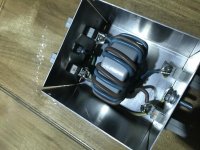Ahtough, in a similar drive, the just powering the drive does NOT trip the GFI. The motor must be commanded to run for the trip to happen. So the filters *could* be the problem.
Easy test is to just bypass them entirely. It's all slip-on crimp connectors, easy test. I would not dismantle the filters either.
What you really are meaning to say is: "how come the main spindle motor runs without tripping the GFI, but the feed motor drive, does?"
Nobody has come up with a theory why THIS is happening.
IIRC, the OP says "....but as soon as the carriage motor is engaged and run up the trip goes down.....".
So the filters are fine with power applied, as they are wired BEFORE the VFDs (on the power side as we have been told and shown).
It is running the motor up to speed that does the deed.
If filters were after the VFD this would be entirely understandable. As far as I know they were OK before being "snipped", and would not be any sort of an issue, in fact they would prevent some noise from going back to (and tripping) the RCD.
Water under the bridge now........
Theory is that the small motor may have a real problem, OR may just be higher capacitance and cause more spike (common mode) noise, which would go along nicely with the trip problem. Seems unusual, but I have seen some strange things.
Everything UP TO the motor and VFD output seems to be well out of it, as that has power applied without tripping anything.
Problem is either 1) with the motor 2) with the VFD 2a) an issue with how the VFD draws power from the line (not as likely, as a bigger one does not.)
The "advisor" seems to be the type who does not ask questions before giving the stock answer to the "Ass-u-me'd" problem, that may have zip to do with the issue.
Or it may be involved, although I'd like to know how, since that runs counter to my experience in similar situations.
I'd like to know for sure if the smaller motor does it with the larger NOT running, and
if it does not, whether the problem then occurs when the larger is turned on.
The problem is that the RCD trips. This can be from:
1) noise leaks back on the line (or otherwise) and does it as a "false trip". (there is no actual ground current)
2) there is a "real leakage" that trips it legitimately (can be noise or power frequency "leaking", and the "leakage" may be in something that is supposed to conduct some current to ground, like a filter)
3) the RCD has a problem
4) something else we have not thought of....


